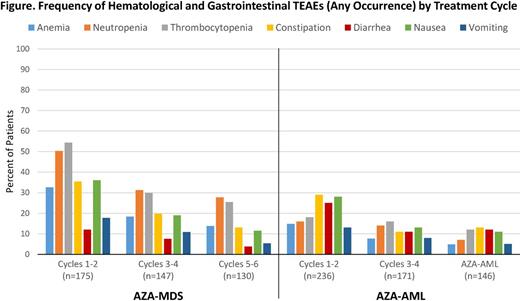Abstract
Background: AML and MDS are distinct, though largely overlapping, diseases, especially in older patients (pts) (Vardiman, Blood, 2008). Injectable AZA is the reference first-line treatment (Tx) for pts with higher-risk (HR) MDS ineligible for alloSCT (NCCN guidelines, v1.2016), as it improved overall survival in this population in the phase 3 AZA-001 (AZA-MDS) trial (Fenaux, Lancet Oncol, 2009). The safety profile of AZA in pts with MDS is well-established from clinical trials and post-marketing reporting (Santini, Eur J Haematol, 2010; Vidaza Package Insert, 2014). Recently, the safety and efficacy of AZA in older pts (≥65 years [yrs]) with AML and >30% marrow blasts were evaluated in the phase 3 AZA-AML-001 (AZA-AML) study (Dombret, Blood, 2015).
Objective: Compare the safety and tolerability profile of AZA Tx in pts with HR-MDS in the AZA-MDS study with that in older pts with AML in the AZA-AML study.
Methods: Safety analyses included all pts who received ≥1 AZA dose. The 2 studies used the same dosing regimen: SC AZA 75 mg/m2/day on days 1-7/28-day cycle. Eligible pts in AZA-MDS were age ≥18 yrs and in AZA-AML were ≥65 yrs. Safety was assessed based on frequency and severity (per CTCAE) of Tx-emergent adverse events (TEAEs), defined as new/worsening AEs during Tx. Tolerability was assessed by overall AZA Tx duration, median cycle length (dosing could be delayed or reduced based on toxicities), rate of AZA dose adjustments, and frequency of TEAEs leading to dose interruption, reduction, or discontinuation.
Results: In AZA-MDS, median age of the AZA safety population (N=175) was 69 yrs (range 42-83) with 22% of pts ≥75 yrs. AZA pts in AZA-AML (N=236) were generally older, consistent with study design: median age 75 yrs (range 64-91) with 56% of pts ≥75 yrs. AZA-AML pts generally had higher ECOG PS (Grade 0-1, 77.6%; Grade 2, 22.5%) than pts in AZA-MDS (Grade 0-1, 92.0%; Grade 2, 6.9%). Pts in AZA-AML had lower median ANC at baseline (0.3x109/L [range 0-12] vs 0.9x109/L [0-38] in AZA-MDS), though median platelet (52 and 61 x109/L, respectively) and hemoglobin (95 and 96 g/L) values were similar. Pts in AZA-MDS received a median of 9 Tx cycles (range 1-39) and pts in AZA-AML received a median of 6 Tx cycles (1-28); overall exposure to AZA was similar: 169 pt-years in AZA-MDS and 175 pt-years in AZA-AML. In AZA-MDS and AZA-AML, respectively, 68% and 53% of pts received ≥6 AZA cycles and 36% and 32% received ≥12 cycles. In AZA-MDS and AZA-AML, 86% and 88% of pts, respectively, received all AZA cycles with no dose adjustments. The most common TEAEs in both studies were hematological and gastrointestinal, which tended to decrease with continued AZA Tx (Figure). Higher frequencies of grade 3-4 thrombocytopenia and neutropenia were reported in AZA-MDS, whereas, frequencies of grade 3-4 febrile neutropenia and pneumonia were higher in AZA-AML (Table). TEAEs that resulted in AZA dose delays or reductions, respectively, were most frequently hematological and occurred in 47% and 11% of pts in AZA-MDS, and 49% and 3.4% in AZA-AML. In AZA-MDS and AZA-AML, TEAEs leading to discontinuation (excluding progression to AML in AZA-MDS) occurred in 13% (most frequently hematological) and 47% (most frequently infections or AML worsened) of pts, respectively. Rates of hematological TEAEs that led to study drug discontinuation were low in both studies (4.6% in AZA-MDS and 4.2% in AZA-AML), suggesting that these events were effectively managed with AZA dose modifications.
Conclusions: The safety and tolerability of AZA in older pts with AML are consistent with the well-established safety profile of AZA in HR-MDS. Higher frequencies of grade 3-4 febrile neutropenia and pneumonia in AML pts may be due to lower baseline ANC values with more pre-existing grade 3-4 neutropenia, as well as pt- and disease-related characteristics. No new or unexpected risks were identified in AZA-treated pts with AML. Rates of common TEAEs with continued Tx in pts with MDS and AML indicate a lack of cumulative toxicity and suggest that adverse effects of AZA are attenuated over time. Clinicians can use similar approaches to managing AZA-related TEAEs in pts with MDS or AML.
Seymour:Genentech, Inc.: Membership on an entity's Board of Directors or advisory committees; Roche: Consultancy, Honoraria, Membership on an entity's Board of Directors or advisory committees, Other: Travel support, Research Funding; Janssen: Honoraria, Membership on an entity's Board of Directors or advisory committees, Research Funding; Gilead: Honoraria, Membership on an entity's Board of Directors or advisory committees; Celgene: Consultancy, Honoraria, Membership on an entity's Board of Directors or advisory committees, Other: Travel support, Speakers Bureau; Incyte: Honoraria, Membership on an entity's Board of Directors or advisory committees; Infinity: Honoraria, Membership on an entity's Board of Directors or advisory committees; Phebra: Consultancy, Honoraria, Membership on an entity's Board of Directors or advisory committees; AbbVie: Consultancy, Honoraria, Membership on an entity's Board of Directors or advisory committees, Other: Travel support, Research Funding, Speakers Bureau; Takeda: Honoraria, Membership on an entity's Board of Directors or advisory committees. Off Label Use: This abstract includes data related to the use of azacitidine in older AML patients with >30% BM blasts (AZA is approved for treatment of AML with 20-30% BM blasts).. Fenaux:AMGEN: Honoraria, Research Funding; CELGENE: Honoraria, Research Funding; JANSSEN: Honoraria, Research Funding; NOVARTIS: Honoraria, Research Funding. Mufti:Celgene Corporation: Honoraria, Membership on an entity's Board of Directors or advisory committees, Patents & Royalties. Santini:celgene, Janssen, Novartis, Onconova: Honoraria, Research Funding. Lucy:Celgene Corporation: Employment, Equity Ownership. Songer:Celgene Corporation: Employment, Equity Ownership. Dougherty:Celgene Corporation: Employment, Equity Ownership. Hinkle:Celgene Corporation: Employment, Equity Ownership. Gambini:Celgene Corporation: Employment, Equity Ownership. Beach:Celgene Corporation: Employment, Equity Ownership.
Author notes
Asterisk with author names denotes non-ASH members.



This feature is available to Subscribers Only
Sign In or Create an Account Close Modal